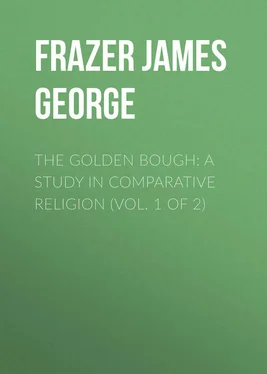James Frazer - The Golden Bough - A Study in Comparative Religion (Vol. 1 of 2)
Здесь есть возможность читать онлайн «James Frazer - The Golden Bough - A Study in Comparative Religion (Vol. 1 of 2)» — ознакомительный отрывок электронной книги совершенно бесплатно, а после прочтения отрывка купить полную версию. В некоторых случаях можно слушать аудио, скачать через торрент в формате fb2 и присутствует краткое содержание. Жанр: foreign_religion, foreign_antique, foreign_prose, на английском языке. Описание произведения, (предисловие) а так же отзывы посетителей доступны на портале библиотеки ЛибКат.
- Название:The Golden Bough: A Study in Comparative Religion (Vol. 1 of 2)
- Автор:
- Жанр:
- Год:неизвестен
- ISBN:нет данных
- Рейтинг книги:4 / 5. Голосов: 1
-
Избранное:Добавить в избранное
- Отзывы:
-
Ваша оценка:
- 80
- 1
- 2
- 3
- 4
- 5
The Golden Bough: A Study in Comparative Religion (Vol. 1 of 2): краткое содержание, описание и аннотация
Предлагаем к чтению аннотацию, описание, краткое содержание или предисловие (зависит от того, что написал сам автор книги «The Golden Bough: A Study in Comparative Religion (Vol. 1 of 2)»). Если вы не нашли необходимую информацию о книге — напишите в комментариях, мы постараемся отыскать её.
The Golden Bough: A Study in Comparative Religion (Vol. 1 of 2) — читать онлайн ознакомительный отрывок
Ниже представлен текст книги, разбитый по страницам. Система сохранения места последней прочитанной страницы, позволяет с удобством читать онлайн бесплатно книгу «The Golden Bough: A Study in Comparative Religion (Vol. 1 of 2)», без необходимости каждый раз заново искать на чём Вы остановились. Поставьте закладку, и сможете в любой момент перейти на страницу, на которой закончили чтение.
Интервал:
Закладка:
Even where no mention is made of wood-spirits, we may generally assume that when a grove is sacred and inviolable, it is so because it is believed to be either inhabited or animated by sylvan deities. In Livonia there is a sacred grove in which, if any man fells a tree or breaks a branch, he will die within the year. 241 241 Grimm, Deutsche Mythologie , 4 , i. 497; cp. ii. 540, 541.
The Wotjaks have sacred groves. A Russian who ventured to hew a tree in one of them fell sick and died next day. 242 242 Max Buch, Die Wotjaken , p. 124.
Sacrifices offered at cutting down trees are doubtless meant to appease the wood-spirits. In Gilgit it is usual to sprinkle goat's blood on a tree of any kind before cutting it down. 243 243 Biddulph, Tribes of the Hindoo Koosh , p. 116.
Before thinning a grove a Roman farmer had to sacrifice a pig to the god or goddess of the grove. 244 244 Cato, De agri cultura , 139.
The priestly college of the Arval Brothers at Rome had to make expiation when a rotten bough fell to the ground in the sacred grove, or when an old tree was blown down by a storm or dragged down by a weight of snow on its branches. 245 245 Henzen, Acta fratrum arvalium (Berlin, 1874), p. 138.
When a tree comes to be viewed, no longer as the body of the tree-spirit, but simply as its dwelling-place which it can quit at pleasure, an important advance has been made in religious thought. Animism is passing into polytheism. In other words, instead of regarding each tree as a living and conscious being, man now sees in it merely a lifeless, inert mass, tenanted for a longer or shorter time by a supernatural being who, as he can pass freely from tree to tree, thereby enjoys a certain right of possession or lordship over the trees, and, ceasing to be a tree-soul, becomes a forest god. As soon as the tree-spirit is thus in a measure disengaged from each particular tree, he begins to change his shape and assume the body of a man, in virtue of a general tendency of early thought to clothe all abstract spiritual beings in concrete human form. Hence in classical art the sylvan deities are depicted in human shape, their woodland character being denoted by a branch or some equally obvious symbol. 246 246 On the representations of Silvanus, the Roman wood-god, see Jordan in Preller's Römische Mythologie , 3 i. 393 note ; Baumeister, Denkmäler des classischen Altertums , iii. 1665 sq. A good representation of Silvanus bearing a pine branch is given in the Sale Catalogue of H. Hoffmann, Paris, 1888, pt. ii.
But this change of shape does not affect the essential character of the tree-spirit. The powers which he exercised as a tree-soul incorporate in a tree, he still continues to wield as a god of trees. This I shall now prove in detail. I shall show, first, that trees considered as animate beings are credited with the power of making the rain to fall, the sun to shine, flocks and herds to multiply, and women to bring forth easily; and, second, that the very same powers are attributed to tree-gods conceived as anthropomorphic beings or as actually incarnate in living men.
First, then, trees or tree-spirits are believed to give rain and sunshine. When the missionary Jerome of Prague was persuading the heathen Lithuanians to fell their sacred groves, a multitude of women besought the Prince of Lithuania to stop him, saying that with the woods he was destroying the house of god from which they had been wont to get rain and sunshine. 247 247 Aeneas Sylvius, Opera (Bâle, 1571), p. 418 [wrongly numbered 420]; cp. Erasmus Stella, “De Borussiae antiquitatibus,” in Novus Orbis regionum ac insularum veteribus incognitarum , p. 510.
The Mundaris in Assam think if a tree in the sacred grove is felled, the sylvan gods evince their displeasure by withholding rain. 248 248 Dalton, Ethnology of Bengal , p. 186.
In Cambodia each village or province has its sacred tree, the abode of a spirit. If the rains are late, the people sacrifice to the tree. 249 249 Aymonier in Excursions et Reconnaissances , No. 16, p. 175 sq.
To extort rain from the tree-spirit a branch is sometimes dipped in water, as we have seen above. 250 250 See above, pp. 13 , 21 .
In such cases the spirit is doubtless supposed to be immanent in the branch, and the water thus applied to the spirit produces rain by a sort of sympathetic magic, exactly as we saw that in New Caledonia the rain-makers pour water on a skeleton, believing that the soul of the deceased will convert the water into rain. 251 251 Above, p. 16 .
There is hardly room to doubt that Mannhardt is right in explaining as a rain-charm the European custom of drenching with water the trees which are cut at certain popular festivals, as midsummer, Whitsuntide, and harvest. 252 252 Mannhardt, B. K. pp. 158, 159, 170, 197, 214, 351, 514.
Again, tree-spirits make the crops to grow. Amongst the Mundaris every village has its sacred grove, and “the grove deities are held responsible for the crops, and are especially honoured at all the great agricultural festivals.” 253 253 Dalton, Ethnology of Bengal , p. 188.
The negroes of the Gold Coast are in the habit of sacrificing at the foot of certain tall trees, and they think that if one of these trees were felled, all the fruits of the earth would perish. 254 254 Labat, Voyage du Chevalier des Marchais en Guinée, Isles voisines, et à Cayenne (Paris, 1730), i. 338.
Swedish peasants stick a leafy branch in each furrow of their corn-fields, believing that this will ensure an abundant crop. 255 255 L. Lloyd, Peasant Life in Sweden , p. 266.
The same idea comes out in the German and French custom of the Harvest-May. This is a large branch or a whole tree, which is decked with ears of corn, brought home on the last waggon from the harvest-field, and fastened on the roof of the farmhouse or of the barn, where it remains for a year. Mannhardt has proved that this branch or tree embodies the tree-spirit conceived as the spirit of vegetation in general, whose vivifying and fructifying influence is thus brought to bear upon the corn in particular. Hence in Swabia the Harvest-May is fastened amongst the last stalks of corn left standing on the field; in other places it is planted on the cornfield and the last sheaf cut is fastened to its trunk. 256 256 Mannhardt, B. K. p. 190 sqq.
The Harvest-May of Germany has its counterpart in the eiresione of ancient Greece. 257 257 Mannhardt, A. W. F. p. 212 sqq.
The eiresione was a branch of olive or laurel, bound about with ribbons and hung with a variety of fruits. This branch was carried in procession at a harvest festival and was fastened over the door of the house, where it remained for a year. The object of preserving the Harvest-May or the eiresione for a year is that the life-giving virtue of the bough may foster the growth of the crops throughout the year. By the end of the year the virtue of the bough is supposed to be exhausted and it is replaced by a new one. Following a similar train of thought some of the Dyaks of Sarawak are careful at the rice harvest to take up the roots of a certain bulbous plant, which bears a beautiful crown of white and fragrant flowers. These roots are preserved with the rice in the granary and are planted again with the seed-rice in the following season; for the Dyaks say that the rice will not grow unless a plant of this sort be in the field. 258 258 H. Low, Sarawak , p. 274.
Customs like that of the Harvest-May appear to exist in India and Africa. At a harvest festival of the Lhoosai of S. E. India the chief goes with his people into the forest and fells a large tree, which is then carried into the village and set up in the midst. Sacrifice is offered, and spirits and rice are poured over the tree. The ceremony closes with a feast and a dance, at which the unmarried men and girls are the only performers. 259 259 T. H. Lewin, Wild Races of South-eastern India , p. 270.
Among the Bechuanas the hack-thorn is very sacred, and it would be a serious offence to cut a bough from it and carry it into the village during the rainy season. But when the corn is ripe in the ear the people go with axes, and each man brings home a branch of the sacred hack-thorn, with which they repair the village cattle-yard. 260 260 J. Mackenzie, Ten years north of the Orange River , p. 385.
Many tribes of S. E. Africa will not cut down timber while the corn is green, fearing that if they did so, the crops would be destroyed by blight, hail, or early frost. 261 261 Rev. J. Macdonald, MS. notes.
Интервал:
Закладка:
Похожие книги на «The Golden Bough: A Study in Comparative Religion (Vol. 1 of 2)»
Представляем Вашему вниманию похожие книги на «The Golden Bough: A Study in Comparative Religion (Vol. 1 of 2)» списком для выбора. Мы отобрали схожую по названию и смыслу литературу в надежде предоставить читателям больше вариантов отыскать новые, интересные, ещё непрочитанные произведения.
Обсуждение, отзывы о книге «The Golden Bough: A Study in Comparative Religion (Vol. 1 of 2)» и просто собственные мнения читателей. Оставьте ваши комментарии, напишите, что Вы думаете о произведении, его смысле или главных героях. Укажите что конкретно понравилось, а что нет, и почему Вы так считаете.












